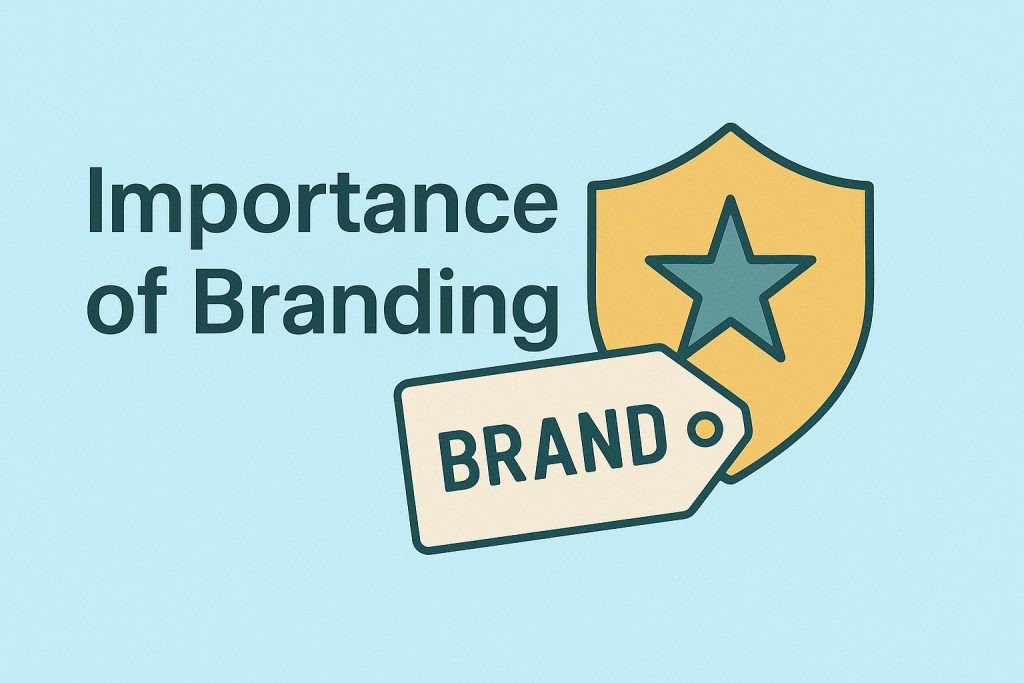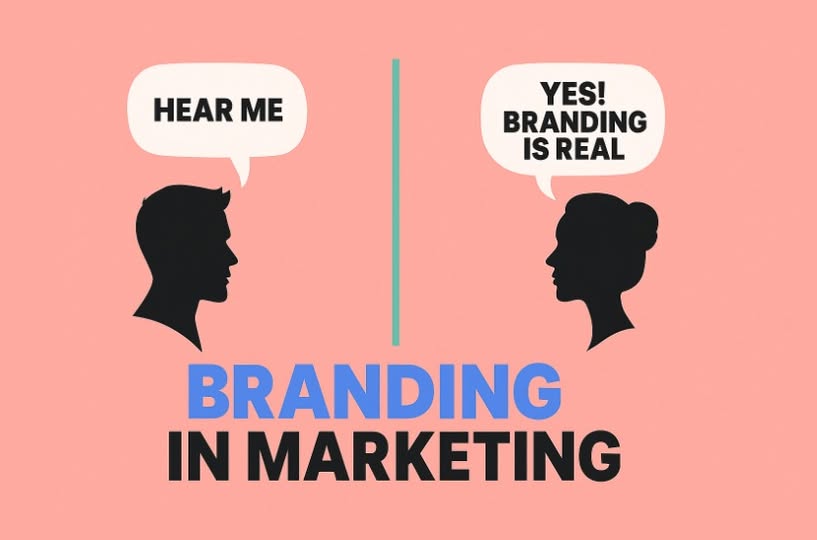You think your product is amazing. You’ve poured countless hours and dollars into developing the best service on the market. But let me ask you a question: if your business disappeared tomorrow, would anyone notice? Would anyone care?
If the answer is no, you don’t have a product problem. You have a branding problem.
So, as a result, you must need to know for your business Importance of Branding to grow branding in marketing to scale your brand or business.

Too many entrepreneurs believe that a great product sells itself. That’s a dangerous myth. The truth is, people don’t buy what you do; they buy why you do it. They buy the story, the feeling, and the promise your brand represents. Branding isn’t just a logo and a color palette. It’s the core of your business’s soul. It’s how you communicate your value, build trust, and create a loyal tribe of customers who will stick with you through thick and thin.
Ignore branding, and you’re just another commodity, forced to compete on price alone. That’s a race to the bottom you can’t win. In this post, I’m going to break down exactly why branding is so critical and give you actionable steps to build a brand that drives serious organic business growth.
What is Branding, Really? (Hint: It’s Not Your Logo)
Let’s clear this up right away. Your logo, your website design, your business cards—those aren’t your brand. They are artifacts of your brand. They are the visual expressions of a much deeper concept.
Your brand is the gut feeling people have about your company. It’s their perception of you, shaped by every single interaction they have with your business. It’s what they say about you to their friends when you’re not in the room.
Think about it:
- When you see the Nike swoosh, you don’t just see a checkmark. You feel motivation, athleticism, and the “Just Do It” attitude.
- When you think of Apple, you don’t just picture a piece of fruit. You think of innovation, sleek design, and a premium user experience.
- When you hear Coca-Cola, you don’t just think of a soft drink. You feel happiness, nostalgia, and a sense of shared moments.
That feeling? That’s the power of branding. It transforms a simple product into an identity.
Branding Drives Recognition and Differentiates You From the Noise
The market is crowded. No matter what industry you’re in, you have competitors. Strong branding is what makes you stand out. It’s your unique fingerprint in a sea of sameness.
Without a distinct brand identity, you’re invisible. A customer might see your ad, visit your website, and even buy from you once. But if there’s nothing memorable about the experience, they’ll forget you the moment a competitor offers a 10% discount.
A cohesive brand identity, one that is consistent across your website, social media, packaging, and customer service builds familiarity. The human brain is wired to trust what it recognizes. When customers see your brand elements repeatedly, it creates a sense of stability and reliability.
This recognition is the first step toward building a lasting relationship.
Great Branding Builds Customer Loyalty and Trust
Why do people line up for hours to buy the latest iPhone when a cheaper phone has similar features? The answer is trust and loyalty, built over decades of consistent branding.
Customers who feel connected to a brand are more likely to:
- Choose you over competitors: Even if your price is slightly higher, loyal customers will stick with you because they trust the quality and value you provide.
- Become brand advocates: They will recommend you to friends and family, creating powerful word-of-mouth marketing that money can’t buy.
- Forgive your mistakes: If you mess up an order, a loyal customer is more likely to give you a chance to make it right than a one-time buyer who has no emotional investment.
Customer loyalty doesn’t happen by accident. It’s the direct result of effective branding strategies that focus on delivering a consistent and positive experience at every touchpoint. When your messaging, values, and actions align, customers learn to trust you. This trust is the foundation of long-term business growth.
Branding Increases Your Perceived Value (And Your Profits)
Strong branding allows you to command a higher price. It’s all about perceived value.
Take two coffee shops. One is a generic cafe with a simple “Coffee” sign. The other is Starbucks. Both sell coffee, but Starbucks sells an experience. The “third place” between home and work, the customized drinks, the familiar green logo—it all adds to the perceived value. That’s why people are willing to pay $5 for a latte they could get for $2 elsewhere.
By building a powerful brand, you shift the conversation from price to value. You’re no longer just selling a product; you’re selling a solution, a status, or a feeling. This strategic positioning gives you pricing power and boosts your profit margins significantly.
Actionable Tips for Building a Killer Brand
Ready to build a brand that people remember? It’s not as complicated as it sounds. Here are some fundamental branding strategies to get you started.
1. Define Your Brand Core
Before you even think about a logo, you need to look inward. Ask yourself the tough questions:
- Why does my business exist? This is your mission. It’s the problem you solve.
- What do we stand for? These are your core values. Are you innovative, eco-friendly, customer-obsessed?
- What is our personality? If your brand were a person, who would it be? Playful and witty? Sophisticated and authoritative?
The answers to these questions form your brand identity. This is your North Star. Every decision you make, from hiring to marketing, should align with this core.
2. Understand Your Target Audience
You can’t be everything to everyone. Trying to appeal to the masses will only make your brand generic and forgettable. Instead, get laser-focused on who your ideal customer is.
- Who are they? (Demographics)
- What do they care about? (Values)
- What are their biggest pain points? (Needs)
- Where do they hang out online? (Channels)
When you deeply understand your audience, you can tailor your messaging, tone, and visual identity to resonate with them on an emotional level. You’re not just selling to them; you’re speaking their language.
3. Craft a Consistent Visual Identity
Once you have your core and your audience defined, it’s time to translate that into visuals. This is where your logo, color palette, typography, and imagery come into play.
Consistency is key. A customer should be able to recognize your brand instantly, whether they see a post on Instagram, an ad on Google, or the packaging on your product. Every visual element should work together to tell the same story. This consistency builds recognition and reinforces the trust you’re working so hard to earn.
4. Tell Your Story Everywhere
Your brand story is the narrative that connects your “why” with your customers’ needs. It’s the human element that makes your brand relatable.
Weave your story into everything you do:
- Your website’s “About Us” page.
- Your social media content.
- Your email marketing campaigns.
- Your customer service interactions.
Don’t just state facts; tell compelling stories that evoke emotion. Share your founder’s journey, highlight customer successes, or give a behind-the-scenes look at how your product is made. Stories are what people remember and share.
Conclusion: Stop Selling, Start Branding
In a world overflowing with choices, the only sustainable advantage you have is your brand. A strong brand elevates you from being a simple choice to being the only choice in the minds of your customers.
It’s the difference between a one-time transaction and a lifetime of customer loyalty. It’s the engine that drives recognition, builds trust, and ultimately fuels sustainable business growth.
Stop thinking of branding as an expense. It’s the single most important investment you can make in the future of your business. Start today by defining your purpose, understanding your audience, and telling a story that people will want to be a part of. That’s how you build a brand that lasts.

